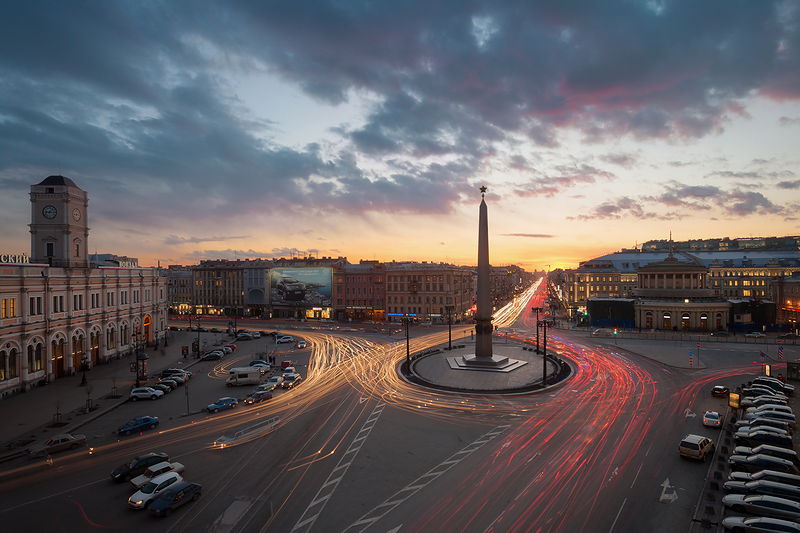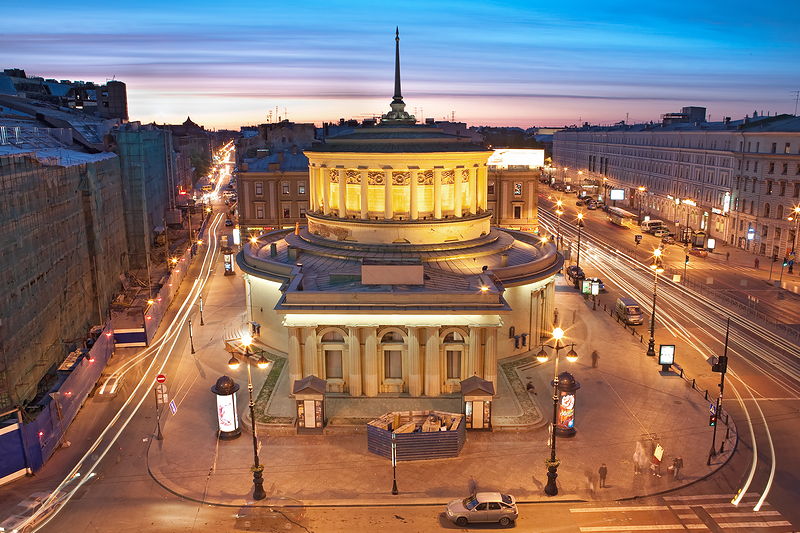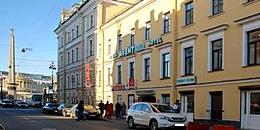Ploshchad Vosstaniya (Uprising Square)
One of the main squares of St. Petersburg, it is located on the corner of Nevsky Prospekt and Ligovsky Prospekt. For thousands of tourists, this area is the first thing they see in the city when leaving the gates of the Moscow railway station. However, do not rush to leave the square as its history holds many interesting turns.
In 1711, on the site of the present square, the work on Nevsky Prospekt met from the opposite sides. However, when the two sides met they realized their construction was too low and inaccurate, so the avenue held a distinctive dip. Here, from south to north, is the ancient Novgorod road, along which the Ligovsky channel was dug from 1718-1721. From 1765-1767, on the corner of Nevsky Prospekt and Ligovsky Canal the wooden Church of the Entry into Jerusalem, popularly known as the Sign, was built upon the orders of Empress Elizabeth Petrovna. From 1794-1804, it was rebuilt in stone, and in 1809, it was enclosed by iron fence with two chapels in the corners.

The square's construction began in 1844 to coincide with the construction of the railway from St. Petersburg to Moscow by architect Nikolai Efimov. Under the plan, the architect Konstantin Ton created Nicholaevsky Station (now Moskovsky), and Alexander Gemilian built a large stone building opposite the station. The building had hotel rooms and a winter garden where balls and concerts were held. The house was first called the hotel "Znamenskaya," or "Severnaya", and after the Revolution "October." The hotel and the station have been reconstructed several times, but their basic architectural shape has remained unchanged to this day.
In 1909, the center of the square was adorned with a bronze equestrian monument to Emperor Alexander III. Its sculptor, Paul Troubetzkoy, worked on the monument for eight years and produced fourteen different variants, two of them in full size. Unfortunately, the fruits of such hard work were not displayed in the square for long, as the monument was dismantled in 1937 and moved to the courtyard of the Russian Museum. Today it can be seen in front of the Marble Palace.

In February 1917, mass demonstrations and clashes with police took place in Znamenskaya Square. In memory of these events the area became known as the Vosstaniya Square (Uprising Square) in 1918. In 1940, under the pretext of building a metro, the Znamenskaya church was demolished and in its place the Vosstaniya Ploschad station was built.
During the siege of Leningrad, the square housed weapons and firepower for the army and turned it into a military stronghold. In 1965, the Soviet government decided to install obelisks in every city in memory of those who fought during the war. For Leningrad, this obelisk was placed on Vosstaniya Square. In 1985, to commemorate the 40th anniversary of the victory over Nazi Germany, a 35-meter column was erected in the square. Vosstaniya Square has become a kind of "sister" of the Palace Square where the Alexander Column is located to honor the victory in the Patriotic War of 1812.
These days Vosstaniya Square is not only a major transport and passenger area, but also a visible memory of the glorious pages of the history of Leningrad/St. Petersburg.
| Metro stations: | Vosstaniya Ploshchad |
|---|---|
| Directions: | Exit Vosstaniya Ploshchad metro station |
| What's here? | To Leningrad the Hero City Obelisk, Moscovsky Railway Station |
| What's nearby? | Nevsky Prospekt, Ligovsky Prospekt |













